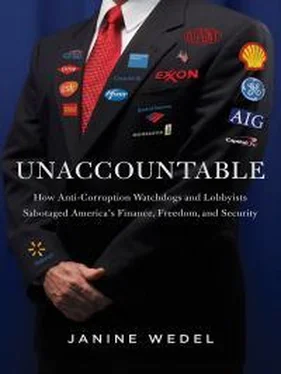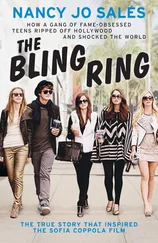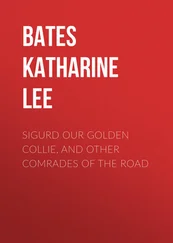Mercatus puts out a lot of product. Of the nearly sixty people listed as scholars on its site, more than a third are professors, mostly at George Mason. 75They regularly appear before Congress or federal agencies, not to mention the news media, sometimes identified as part of Mercatus, sometimes as professors, sometimes both. 76While those they are addressing may know that Mercatus is backed by energy-industry billionaires who virulently oppose regulation, the public, by and large, does not. One Mercatus scholar recently drew the attention of The Nation, and not even for his Mercatus association. He testified before a congressional committee, with no mention that he serves as a “director of the Global Economics Group, a consulting business that boasts in a brochure that its experts have been hired by industry to influence the [Consumer Financial Protection Bureau] and other regulatory agencies.” 77
Another Mercatus scholar “testified before Congress on the costs of Dodd-Frank [and] . . . billed lobbying firm Greenberg Traurig (which represented the U.S. Chamber of Commerce and Nomura Holdings, among other firms) nearly $50,000 for his consulting work.” 78You won’t find this on his Mercatus page, which notes that he is on leave to serve as the chief economist for the House Financial Services Committee. 79
When a firm promises that its “experts” will “make strong cases to support desired outcomes,” that sounds a lot like lobbying and nothing like scholarship. There’s plenty of irony in scholars profiting as they attacked the Consumer Financial Protection Bureau, brainchild of Senator Elizabeth Warren. That’s because she studied the problem of “scholars for dollars” herself when she was Professor Warren. 80
In the bankruptcy area, data providers, such as the Credit Research Center located at Georgetown University, have taken money from the consumer credit industry to produce studies supporting the credit industry’s political positions. In the case of the CRC, the studies bear the University logo, but the Center describes the data as “proprietary,” belonging exclusively to the industry funders who decide what data are released and what data are held private.
That, of course, is anathema to academic norms of open research and publication.
As university budgets are strained and states reduce their contributions to public universities, pressure mounts for scholars, centers, and institutes to secure funding. University leaders and entire cadres of administrators are now deployed to beg for private and governmental dollars. Indeed, to have a better life at many universities, including my own—for instance, to secure summer salary, research assistance, travel funds—university entities and individual scholars need to raise money. At least some of that funding comes from corporations and other entities or individuals with advocacy agendas. As scholars are more for hire and universities succumb to the blending and blurring that have befallen other institutions, so do ethics blur.

As we have seen in this chapter, one ever-more-prevalent way to organize influence involves using and abusing the supposed impartiality of the scholar/economist/physician/researcher and the academy itself. Again and again we have observed that, when appearances are not what they purport to be, our trust is violated.
Yet another way to organize influence, as we shall soon see, is to use and abuse the image of grassroots and nongovernmental organizations.
CHAPTER 9
“Grassroots” and Nonprofit Organizers
In what and whom do we trust? As we’ve seen throughout this book, our trust in formal institutions has been giving way to faith in the private domain: the blogger we feel we know; our friend who sends us articles to read, thereby acting as our editor; our participation in the “sharing economy.” Disillusioned with formal institutions, we turn to private ones.
Our attraction to things “private” leaves us susceptible to efforts that appear private, as if they were coming from likeminded souls. We are so enamored of the we-can-do-this-together spirit that a lot of influence is organized to appear as if it were coming from a genuine community effort, that is, from the grass roots. We like it so much that those who want to influence us organize themselves under the rubric of nonprofit organizations—that is, private ones. We like it so much that politicians and their wealthy donors organize their efforts informally and to happen outside public institutions like political parties.
Perhaps the only people who like these “grassroots” efforts more than we do are their organizers, because the grassroots cachet is so effective in accomplishing their goal. That is, influencing us.
The use of what in common parlance are “fake grassroots” or “front groups” is not new by any means. But the advent of the Internet and social media, as well as the decline of investigative journalism, has made it far easier and cheaper to channel secret influence, propaganda, and money. These developments have also nurtured simulacra—things that suck us in because they appear to be something else but aren’t. The digital age has sired a surge of “astroturfing,” in which companies, politicians, and other organizations fake a grassroots campaign to get their message across, leading the public to believe there is a groundswell of support rather than a few self-interested sponsors. Astroturfing predates the Internet, but the Internet makes astroturfing easier than ever before. 1The result of all this is that you can buy your morning coffee and more easily trace the source of the individual bean than it would be to trace the source of information that subtly influences your views on the most important public-policy issues of the day.
And influence such groups do, beyond the reach of accountability to us, the public.
The signposts for this form of influencing, straight from the shadow-elite playbook, should, by now, be familiar:
Tame or grassroots-sounding names, evoking citizens’ advocacy or genuine DIY efforts. Organizations and efforts that are staged from the top—be they by one or a handful of billionaires or a tiny cadre around a president. Entities that morph their purposes as convenient for their puppet-masters. Organizations sponsored by companies or the super-rich to create an echo chamber and make it appear that there’s a “there there” when there isn’t. The use of big names or former top officials to give organizations heft. Sponsorship and funding sources that are indirect and almost impossible to track. In short, an enterprise whose influence is steeped in obscurity and lends itself to deniability.
In this chapter, I’ll look at the use of “grassroots” groups and efforts employed by both corporations and self-interested individuals and networks, and amplified by digital means. I’ll also look at how political parties and ideological billionaires use their own “nonprofit” groups, often supported by donors whose identity is in the shadows, to make you believe that it’s your voice that matters, not theirs.
TOP-DOWN “GRASSROOTS”
In the United States, tobacco companies are perhaps the most accomplished corporate group when it comes to PR. In the 1950s, the industry perfected the state of the art through such techniques as placing ads, ghostwriting articles, courting media personnel and providing them with favorable copy, anticipating and countering unfavorable publicity, and mass circulation of favorable “news.” 2
As time went on, the industry also tried to create a supposed groundswell of grassroots involvement—in their case, to oppose the encroaching restrictions on smoking.
Читать дальше













